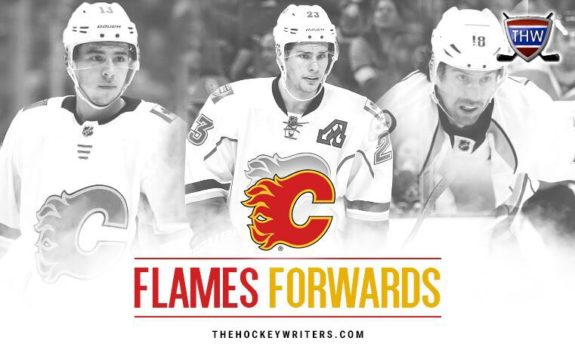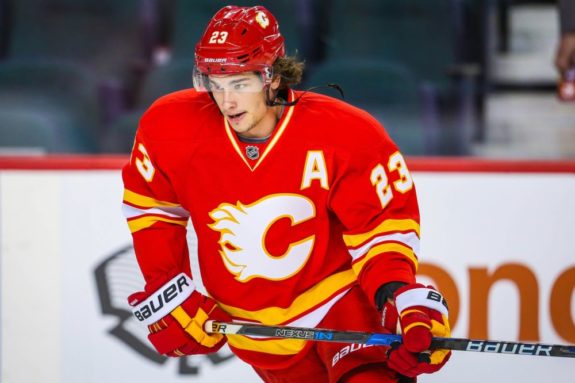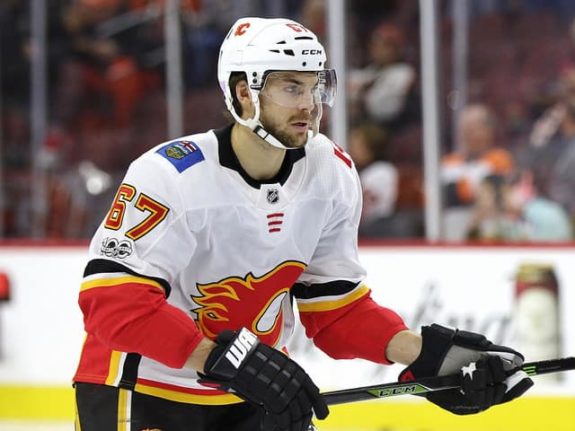The 2017-18 edition of the Calgary Flames were a strangely constructed hockey club. On paper, they were a team with a few sure-fire offensive contributors among their forward ranks and several question marks further down in the rotation. The thought was maybe some of their iffy players would take a big leap forward or at least bounce back from down seasons.

Unfortunately, that generally didn’t happen and the Flames remained a team that only went as far as their big offensive weapons would take them. It made them an easy team to game-plan against and, as injury gradually depleted their line-up, ended up with the Flames sliding out of the Western Conference playoff picture. Heading into the 2018-19 season, Flames management has made several changes to their club with the aim of adding depth and making the team more difficult to play against.
Following in the footsteps of the glance at the team’s back-end, here’s our rundown of the Flames’ projected forward ranks heading into training camp.
The Top Six
| Johnny Gaudreau | Sean Monahan | James Neal |
| Matthew Tkachuk | Mikael Backlund | Elias Lindholm |
Adding to his club’s top two forward lines was Brad Treliving’s big summer task and he seems to have delivered in spades. James Neal has been one of the most consistent goal-scorers in the entire National Hockey League over the past several seasons, but he’s also renowned for being a complete pain to play against. Never afraid to crash and bang in the corners, Neal’s physicality and competitiveness will likely fit in nicely on a top Flames forward line that includes cerebral center Sean Monahan – finally recovered from four offseason surgeries – and speedster Johnny Gaudreau.

The second line gets an injection of youth in the form of former Carolina Hurricanes forward Elias Lindholm. A two-way forward very much in the mold of fellow Swede (and new linemate) Mikael Backlund, Lindholm potentially upgrades a line that also includes fellow up-and-comer Matthew Tkachuk, himself an offensive-minded pest in the vein of Neal. If Lindholm can spark the offense for his line a bit, and Tkachuk keeps improving, the offensive drop-off between the top two lines might be somewhat muted. Having Backlund and Lindholm available to take face-offs will help the coaching staff deploy them strategically, as well.
The Bottom Six
| Sam Bennett | Derek Ryan | Michael Frolik |
| Dillon Dube | Mark Jankowski | Austin Czarnik |
Here’s where the acquisitions of Neal and Lindholm really start to potentially strengthen the team’s depth. Adding those two wingers likely bump veteran Michael Frolik to the third line, where he’ll likely play with Sam Bennett and free agent signing Derek Ryan. Ryan gives the team something they haven’t had in awhile – a right-shot center – while Bennett can take draws from the left side. More importantly, Ryan and Frolik both provide some two-way stability that Bennett’s linemates haven’t had in recent seasons, which could potentially allow him to pay more attention to creating offense than he has in the past. Bennett also provides the type of agitating presence that Neal and Tkachuk bring to the top six.

The fourth line will arguably see the biggest change from last season. Mark Jankowski scored 17 goals as a rookie last season, but depth up the middle bumps him down to the fourth line, where he’ll likely play with versatile winger (and free agent signing) Austin Czarnik. The big question mark is who settles in on the left side of that line. One player that will get a ton of consideration is rookie Dillon Dube, best known for his strong performances with the Kelowna Rockets and Team Canada’s last two World Junior squads. Dube developed into a very tenacious forechecker and a pain to play against while wearing the maple leaf, which would be a great fit on the Flames’ fourth line. The big gap for the Flames last season was the big drop-off – in talent, speed and energy – experienced when the fourth line hit the ice; crafting a young, speedy, tenacious unit would go a long way towards maintaining in-game momentum.
The Extras
| Garnet Hathaway | Anthony Peluso |
The Flames have oodles of players that can line up at center in the event of injury, so their ideal 13th and 14th forwards are players that aren’t expensive, don’t need to play every day, but can step in and help out on the wings in a pinch. Garnet Hathaway and free agent signing Anthony Peluso both have low cap hits ($850,000 for Hathaway and $650,000 for Peluso) and can slot in on the right side of the bottom six. They’re both at the point where they’ve topped out development-wise, and having them as players to slot in every few games and give the team a boost of energy or physicality wouldn’t be a bad fit.
The Next Men Up
Presuming the prior 14 forwards make the team out of camp, four wingers are the most likely candidates for immediate call-ups depending on circumstances and their performances to begin the season. The quartet are Curtis Lazar, Andrew Mangiapane, Spencer Foo and Morgan Klimchuk. The Flames have several center options, which allows them to tap their reserves for help on the wing if needed.
Lazar may be close to having the “bust” label stamped upon him, but he’s still very young and a strong skater. But he needs some time in the AHL – which will require clearing waivers – to boost his confidence with the puck. Mangiapane and Foo were among the Stockton Heat’s best offensive contributors and could provide some speed and offensive from the left and right wings, respectively. Finally, Klimchuk is arguably the organization’s best up-and-coming two-way player and could provide some speed and defensive smarts on the bottom two forward lines in a pinch.
A Deeper Club
After all of Treliving’s summer moves, the Flames have a deeper forward group headed into 2018-19 than they had in 2017-18. Time will tell if they have a better, more offensively potent one.